Review: Yogyakarta to Surabaya (Indonesia) by Train
In this review we travel on the ‘Sancaka’ train of the Indonesian National Railways (Kereta Api Indonesia) from Yogyakarta to Surabaya.
Yogyakarta
After spending three nights in Yogyakarta it was time to move on across the island of Java and head to Surabaya.
I had a great time in Yogyakarta, from where I visited the amazing temples of Borobudur and Prambanan.
Unfortunately I didn’t really manage to see the sights in the city of Yogyakarta itself as for most of the days I was stuck in my hotel having to work on my laptop.


Taking the train
Although you can also fly between Yogyakarta and Surabaya or take a bus, taking the train is probably the most convenient, comfortable and cheapest way to travel.
Where flight schedules can be rather thin, there are a couple of daily departures by train between these two cities.
Besides, taking the train allows you to absorb the beautiful landscape of Indonesia to a much greater extent than you can possibly do from a plane window.
Even though most Indonesian trains aren’t exactly high speed – it isn’t that slow either.
Yogyakarta to Surabaya takes just under 5 hours. If you compare that to a flight and add check-in cut-offs and time spent reaching out-of-city airports, the time difference isn’t that big.
For a great general guide about rail travel in Indonesia and an overview of all different classes on trains across the entire country, I can highly recommend the excellent website of The Man in Seat 61.
Tugu Yogyakarta to Surabaya Gubeng
‘Sancaka’ Express train
Departure: 6.45am – Arrival: 11.37am
Duration: 4h52m – Distance: 310 kilometres
Wagon 5, seat 7A (Eksekutif Class)
Costs: 13 EUR
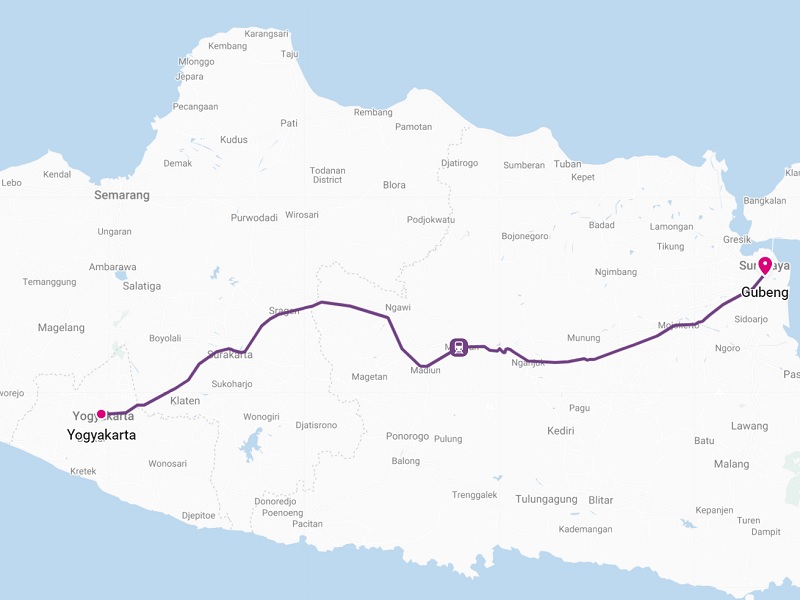
Exchanging my e-ticket
I managed to book my ticket online at tiket.com – an Indonesian online booking websites for flights, trains and hotels.
On the website, you simply have to go to ‘Tiket Kereta Api’ to book your Indonesian train ticket (Kereta Api – which literally means ‘fire carriage’ – are the national railways of Indonesia).
You can select your seat in the train at the hand of simplified seat maps and pay for your ticket using your credit or debit card. Of course, you can also buy your ticket at the station when you arrive in Indonesia.
If you buy a ticket online, you do however need to exchange it for a real paper ticket at one of the ticket booths or ticket machines at the station.
Apparently the ticket machines are quite easy to use, but for some reason I just didn’t manage to scan the barcode on my e-ticket or to find the option to manually type in my booking code.
Fortunately a friendly local helped me out and managed to scan my ticket, after which I could print out the required boarding pass.

Tugu Yogyakarta
Yogyakarta’s main station is called Tugu Yogyakarta and is a short walking distance away from the city centre.
When you have the boarding pass of your train in hand, you can proceed from the ticket counters to the station platforms.
Although there is a security check point where they check whether the name on your boarding pass matches your passport or ID card, there is no luggage check.
As it was early in the morning and I didn’t had breakfast yet, I bought a pastry and a great brew of coffee at one of the station shops.

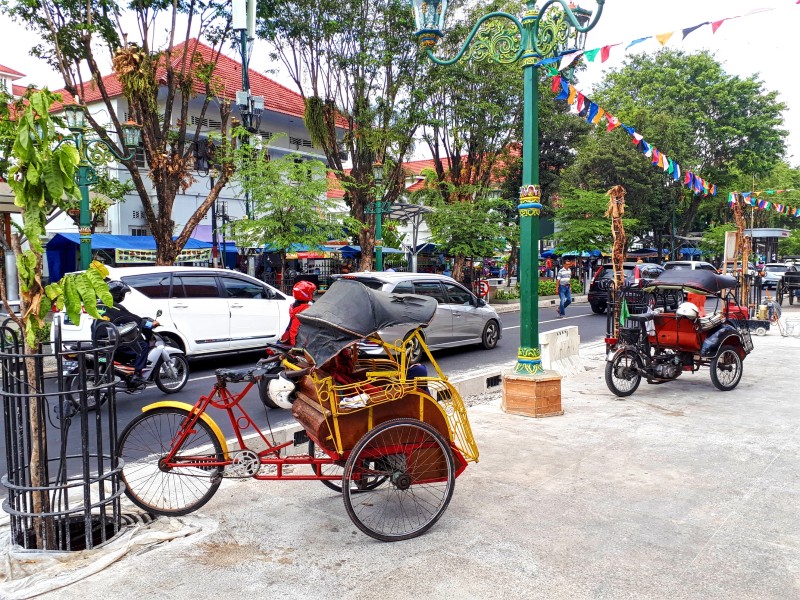


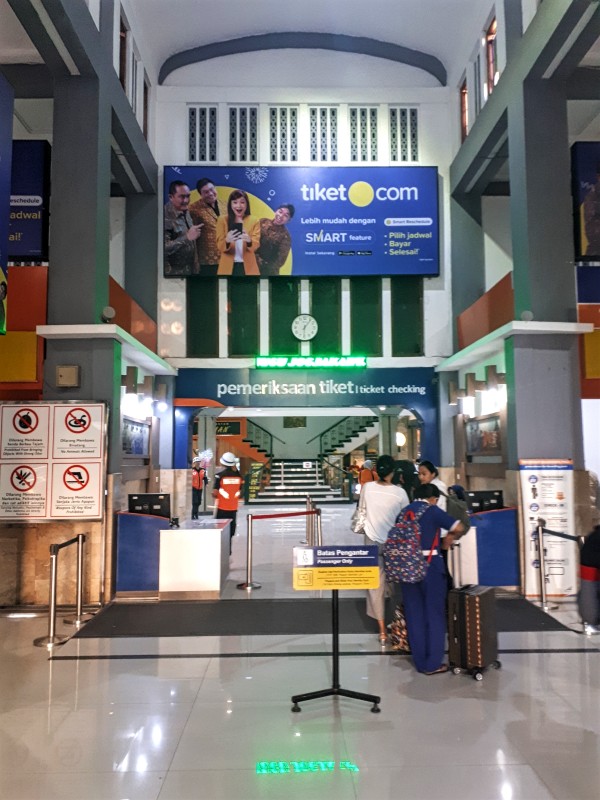
The Sancaka arrives
Although the Sancaka originates its journey in Yogyakarta, it had not arrived yet at the designated platform.
I therefore killed the time by walking a bit around the beautiful train station to take a couple of pictures.
At around 10 minutes before departure, the Sancaka express train slowly rolled into Tugu Yogyakarta station.

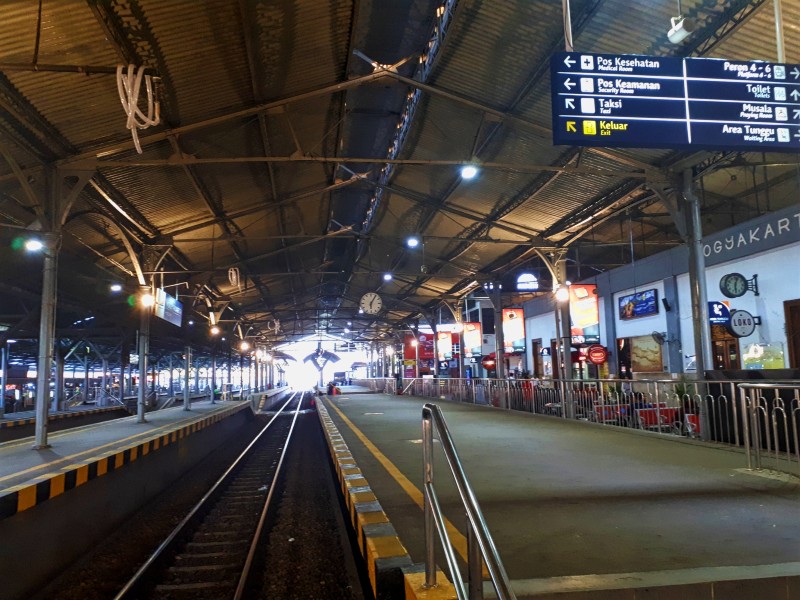

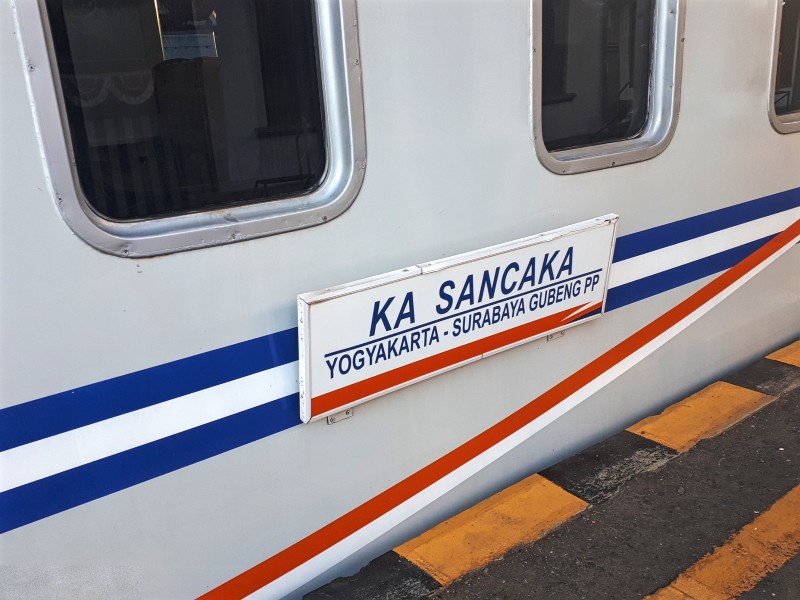

Train classes in Indonesia
Indonesian trains come basically in three classes. The cheapest is ‘ekonomi class’ (economy class) which usually consists out of three-seater benches on one side of the aisle and a bench for two at the other side (2+3).
Business class (called ‘bisnis’ in Indonesia) is a bit more spacious as its two across on benches on each side of the aisle (2+2).
One step up from bisnis is ‘eksekutif’ (executive class). Although this is also 2+2 seating at each side of the aisle, the difference with business class is that these are individual seats with armrests instead of padded benches.
Eksekutif seats are not only more spacious and comfortable, but they also recline up to some 30 degrees while bisnis class benches do not recline.
Some trains out of Jakarta now also feature ‘Eksekutif Luxury’ class which features seats like those in long-haul business class on an airline, although you won’t currently find them on the train service between Yogyakarta and Surabaya.
All seats on Indonesian intercity trains – even those in ekonomi class carriages – do have power sockets. You should however not expect any WiFi internet on board.

Food and drinks
Every long-distance train in Indonesia has a restaurant wagon with a counter where you can buy some food and drinks. The same meals and beverages are also sold from a trolley which is pushed down the train.
I however did not try out any of the food myself so I cannot comment on the quality!
Scenery
Having found my carriage and seat on the Sancaka train, I settled down and enjoyed my freshly brewed coffee and tasty breakfast pastry as the train rolled out of the station.
After leaving Tugu Yogyakarta station, the Sancaka sneaks through the suburbs of this large Javan city which is home to some 2 million people in the larger metro area.
The best views from the train are on your left hand side. In the first hour after leaving Yogyakarta you will encounter some great views over the active stratovolcano of Mount Merapi and endless rice paddies.
Even though my seat was on the right-hand side of the train, there were fortunately plenty of empty places in the carriage throughout the journey, which allowed me to move over to the other side to snap some pictures of the Merapi volcano.



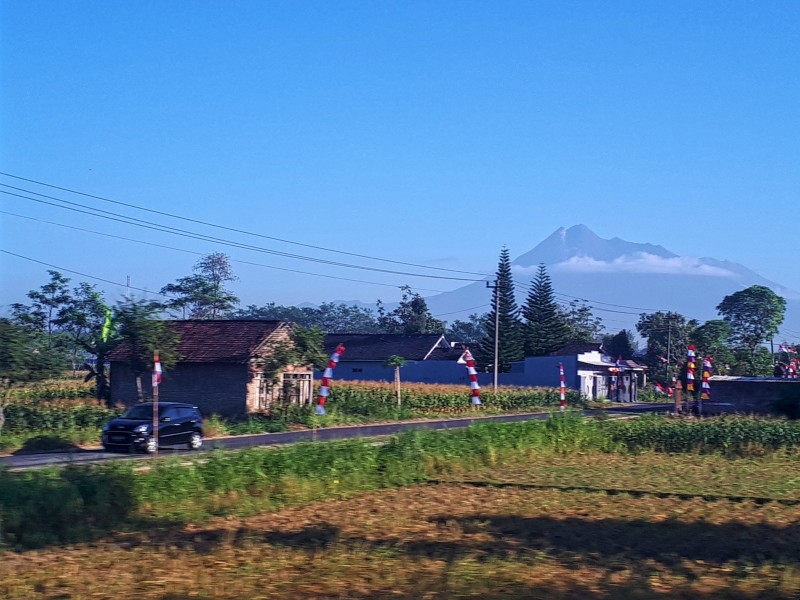

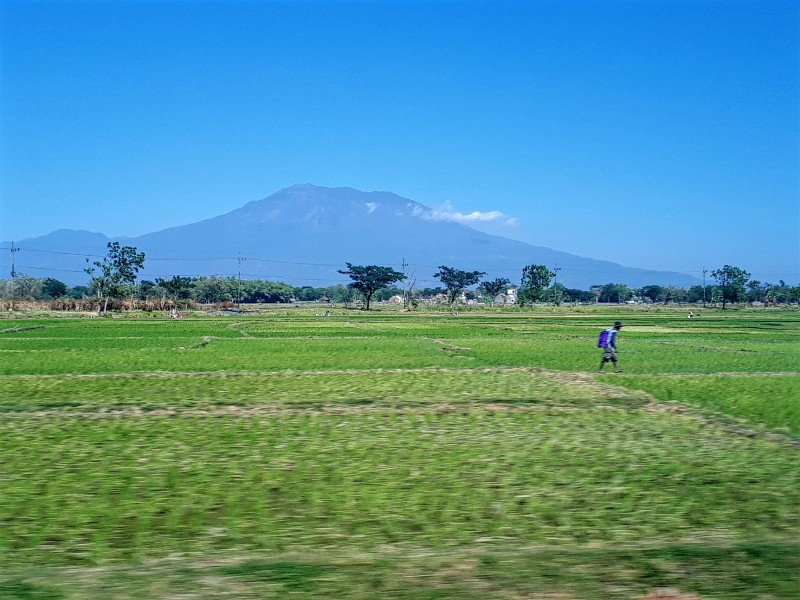
Solo
About one hour out of Yogyakarta, the Sancaka calls at Surakarta (better known as Solo) – by far the biggest city and most important stop on the line between Yogyakarta and Surabaya.
Besides the stop at Solo, the rest of the journey was rather unremarkable. Although the views over the endless rice paddies and Javan towns were far from boring, the scenery was all a bit flat and repetitive after a while.
As I was a bit tired from the early departure and intensive couple of days before, I ended up dozing off for the remainder of the journey, only waking up when the train rolled into the outskirts of Surabaya.
In the end, the Sancaka express train arrived on the dot at Surabaya Gubeng station.
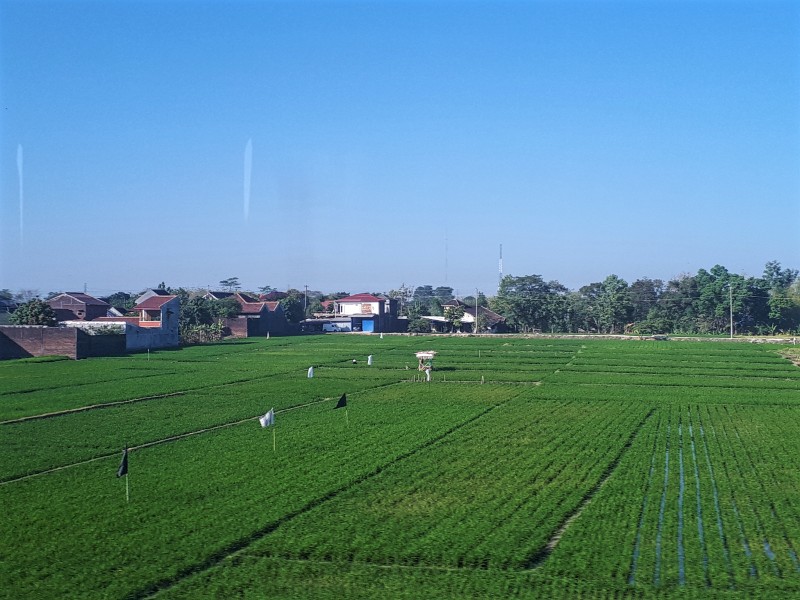

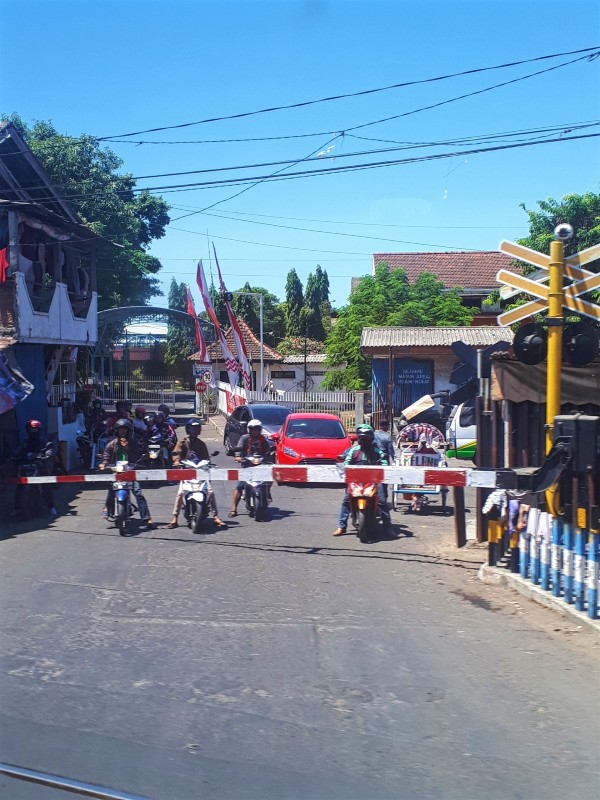


Conclusion
The train journey from Yogyakarta to Surabaya made for a fun ride. My ‘eksekutif class’ seat was spacious and comfortable and the views over the Indonesian landscape – especially the first hour after leaving Yogyakarta – were beautiful.
Seeing the endless rice paddies and local life in the small towns of Java from the train window is just a special experience which you won’t have from a plane at 30,000 feet.
Best of all were the stunning views over Mount Merapi – the famous volcano which dominates the landscape of central Java.
Train travel in Indonesia is therefore highly recommended. In this case travelling between Yogyakarta and Surabaya it doesn’t even take much longer than flying.
The Indonesian Railways run a smooth and efficient operation, tickets are cheap and can be easily booked online, and it makes for a more interesting adventure than taking a domestic flight and will be way more comfortable than travelling by bus. By all means, go for it!
Trip report index
This article is part of the ‘Journey to Java‘ trip report, which consists of the following chapters:
1. Review: Wizz Air Bucharest to Rome Ciampino (Airbus A321)
2. Half a Day in Rome: A Walk Around the Eternal City
3. Review: Casa Alitalia Lounge ‘Piazza di Spagna’ Rome Fiumicino Airport
4. Review: Saudia Business Class Rome to Riyadh (Airbus A320)
5. Review: Saudia Alfursan Business Lounge Riyadh Airport
6. Review: Saudia Business Class Riyadh to Jakarta (Boeing 777-300)
7. Review: The Hermitage, a Tribute Portfolio Hotel, Jakarta, Indonesia
8. A Day in Jakarta: Exploring Indonesia’s Bustling Capital City
9. Review: Garuda Indonesia Domestic Business Lounge Jakarta Airport
10. Review: Garuda Indonesia Business Class Jakarta to Yogyakarta (Boeing 737-800)
11. Review: The Phoenix Hotel Yogyakarta – Mgallery By Sofitel
12. A Magical Sunrise Visit to Borobudur Temple
13. A Visit to the Great Hindu Temple Complex of Prambanan
14. Review: Yogyakarta to Surabaya (Indonesia) by Train (current chapter)
15. Review: Majapahit Hotel, Surabaya, Indonesia
16. A Day in Surabaya: Exploring Indonesia’s Second Biggest City
17. Review: Concordia Premier Lounge Surabaya Airport
18: Review: Singapore Airlines Business Class Surabaya to Singapore (Airbus A330-300)
19. A Short Singapore Stopover: Into the City or Stay at the Airport?
20. Review: SilverKris Lounge Singapore Changi Airport Terminal 2
21. Review: Singapore Airlines Business Class Singapore to Manila (Boeing 787-10)
22. Review: PAGSS Business Lounge Manila Airport Terminal 1
23. Review: China Airlines Economy Class Manila to Taipei (Airbus A330-300)
24. Review: China Airlines Business Lounge Taipei Airport Terminal 1
25. Review: China Airlines Economy Class Taipei to Rome (Airbus A350)
26. Review: TAROM Economy Class Rome to Bucharest (Boeing 737-700)

